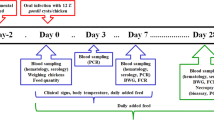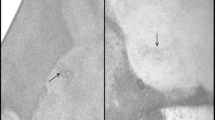Abstract
To date, there are no reports regarding comparison between different bird species in Neospora. caninum infection. In the present study 70 embryonated eggs from quail, partridge, broiler and egg laying chickens were divided into 7 groups equally. Six groups in each species were inoculated with different dilutions (10, 102, 103, 104, 105, and 106) of tachyzoites/embryonated egg in the chorioallantoic membrane and the seventh group was considered as control. The mortality rates and clinical signs were studied. All the egg laying chickens and some of the broiler chickens and quails showed neurologic signs like. The results revealed that the mortality rate was dose dependent in broiler chicken embryonated eggs. But mortality rate was dose independent in egg laying chickens and quail. Partridge revealed 100 % mortality rate in all doses. The LD50 in broiler chicken embryonated was 102.3. In conclusion, LD50 in the broiler chickens is the lowest between different animal models which shows that the broiler chicken embryonated egg is the best animal model for experimental inducing of neosporosis. Partridge is the most susceptible bird to N. caninum infection. These results reinforce that there is genetic susceptibility to N. caninum in chickens like mice and provide new insights to reach an inexpensive and available animal model for N. caninum infection.
Similar content being viewed by others
Abbreviations
- N. caninum :
-
Neospora caninum
- CA:
-
Chorioallantoic
References
Dubey JP (2003) Neosporosis in cattle. J Parasitol 89:S42–S56
Dubey JP, Carpenter JL, Speer CA, Topper MJ, Uggla A (1988) Newly recognized fatal protozoan disease of dogs. J Am Vet Med Assoc 192:1269–1285
Furuta PI, Mineo TWP, Carrasco AOT, Godoy GS, Pinto AA, Machado RZ (2007) Neospora caninum infection in birds: experimental infections in chicken and embryonated eggs. Parasitology 134:1–9
Gondim LF, McAllister MM, Pitt WC, Zemlicka DE (2004) Coyotes (Canis latrans) are definitive hosts of Neospora caninum. Int J Parasitol 34:159–161
Khodakaram-Tafti A, Mansourian M, Namavari M, Hosseini A (2012) Immunohistochemical and polymerase chain reaction studies in Neospora caninum experimentally infected broiler chicken embryonated eggs. Vet Parasitol 188:10–13
Khordadmehr M, Khodakarm-Tafti A, Namavari M, Mansourian M, Karimiyan A, Rahimian A (2012) Effect of host cell on virulence of Neospora caninum. Online J Vet Res 16:38–48
Lindsay DS, Lenz SD, Cole RA, Dubey JP, Blagburn BL (1995) Mouse model for central nervous system Neospora caninum infections. J Parasitol 81:313–315
Long MT, Baszler TV, Mathison BA (1998) Comparison of intracerebral parasite load, lesion development, and systemic cytokines in mouse strains infected with Neospora caninum. J Parasitol 84:316–320
Mansourian M, Khodakaram-Tafti A, Namavari M (2009) Histopathological and clinical investigations in Neospora caninum exper imentally infected broiler chicken embryonated egg. Vet Parasitol 166:185–190
McAllister MM, Dubey JP, Lindsay DS, Jolley WR, Wills RA, McGuire AM (1998) Dogs are definitive hosts of Neospora caninum. Int J Parasitol 28:1473–1478
Namavari M, Mansourian M, Khodakaram-Tafti A, Hosseini MH, Rahimiyan A, Khordadmehr M, Lotfi M (2011) Application of chicken embryonated eggs as a new model for evaluating the virulence of Neospora caninum tachyzoites. Comp Clin Pathol 21:1665–1668
Pan Y, Jansen GB, Duffield TF, Hietala S, Kelton D, Lin CY, Peregrine AS (2004) Genetic susceptibility to Neospora caninum infection in Holstein cattle in Ontario. J Dairy Sci 87:3967–3975
Pizzi M (1950) Sampling variation of the fifty percent end-point, determined by the Reed–Muench (Behrens) method. Hum Biol 22:151–190
Que X, Wunderlich A, Joiner KA, Reed SL (2004) Toxopain-1 is critical for infection in a novel chicken embryo model of congenital toxoplasmosis. Infect Immun 72:2915–2921
Warren J, Russ SB (1948) Cultivation of toxoplasma in embryonated eggs–an antigen derived from chorioallantoic membrane. Proc Soc Exp Biol Med 67:85–89
Wunderlin E, Wild P, Eckert J (1997) Comparative reproduction of Cryptosporidium baileyi in embryonated eggs and in chickens. Parasitol Res 83:712–715
Author information
Authors and Affiliations
Corresponding author
Rights and permissions
About this article
Cite this article
Mansourian, M., Namavari, M., Khodakaram-Tafti, A. et al. Experimental Neospora caninum infection in domestic bird’s embryonated eggs. J Parasit Dis 39, 241–244 (2015). https://doi.org/10.1007/s12639-013-0327-0
Received:
Accepted:
Published:
Issue Date:
DOI: https://doi.org/10.1007/s12639-013-0327-0




